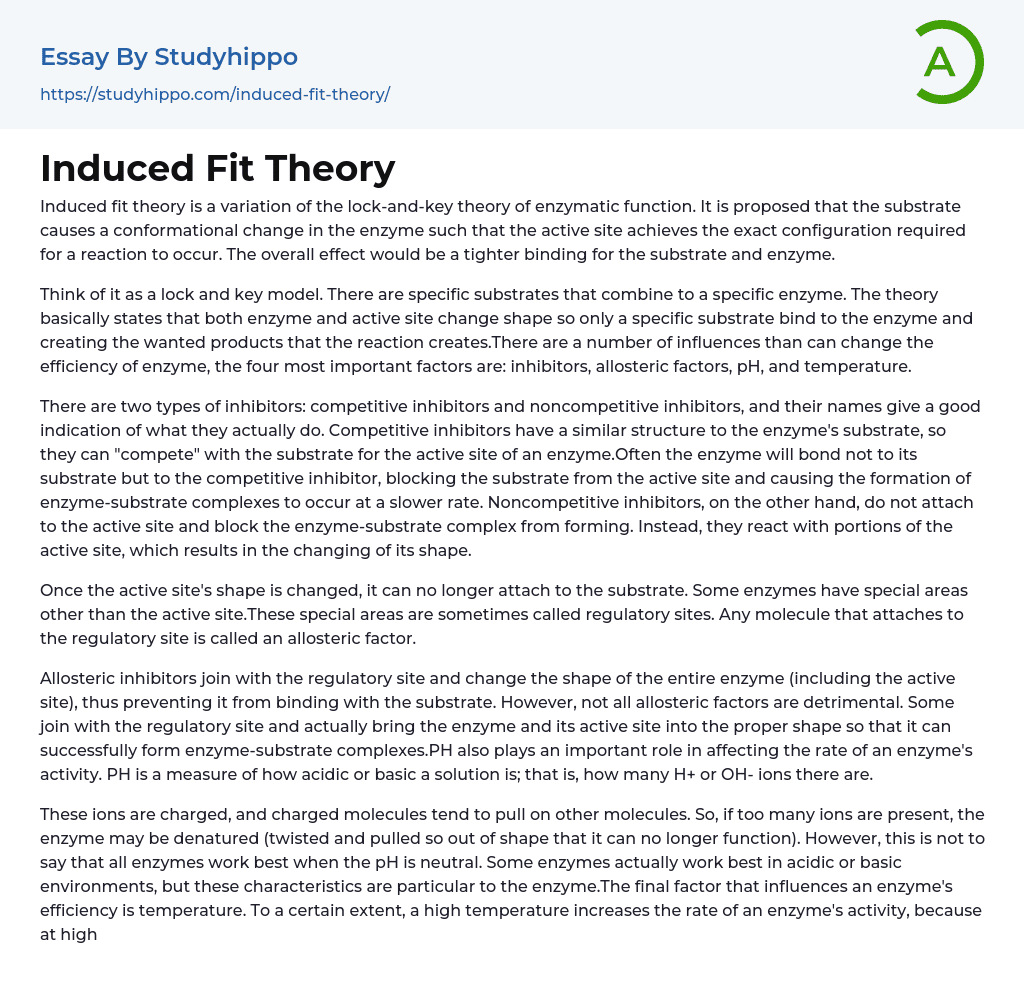Induced fit theory is a variation of the lock-and-key theory of enzymatic function. It is proposed that the substrate causes a conformational change in the enzyme such that the active site achieves the exact configuration required for a reaction to occur. The overall effect would be a tighter binding for the substrate and enzyme.
Think of it as a lock and key model. There are specific substrates that combine to a specific enzyme. The theory basically states that both enzyme and active site change shape so only a specific substrate bind to the enzyme and creating the wanted products that the reaction creates.There are a number of influences than can change the efficiency of enzyme, the four most important factors are: inhibitors, allosteric factors, pH, and temperature.
There are two types of inhibitors: competitive inhibitors and noncompeti
...tive inhibitors, and their names give a good indication of what they actually do. Competitive inhibitors have a similar structure to the enzyme's substrate, so they can "compete" with the substrate for the active site of an enzyme.Often the enzyme will bond not to its substrate but to the competitive inhibitor, blocking the substrate from the active site and causing the formation of enzyme-substrate complexes to occur at a slower rate. Noncompetitive inhibitors, on the other hand, do not attach to the active site and block the enzyme-substrate complex from forming. Instead, they react with portions of the active site, which results in the changing of its shape.
Once the active site's shape is changed, it can no longer attach to the substrate. Some enzymes have special areas other than the active site.These special areas are sometimes called regulator
sites. Any molecule that attaches to the regulatory site is called an allosteric factor.
Allosteric inhibitors join with the regulatory site and change the shape of the entire enzyme (including the active site), thus preventing it from binding with the substrate. However, not all allosteric factors are detrimental. Some join with the regulatory site and actually bring the enzyme and its active site into the proper shape so that it can successfully form enzyme-substrate complexes.PH also plays an important role in affecting the rate of an enzyme's activity. PH is a measure of how acidic or basic a solution is; that is, how many H+ or OH- ions there are.
These ions are charged, and charged molecules tend to pull on other molecules. So, if too many ions are present, the enzyme may be denatured (twisted and pulled so out of shape that it can no longer function). However, this is not to say that all enzymes work best when the pH is neutral. Some enzymes actually work best in acidic or basic environments, but these characteristics are particular to the enzyme.The final factor that influences an enzyme's efficiency is temperature. To a certain extent, a high temperature increases the rate of an enzyme's activity, because at high temperatures, molecules move around faster, so an enzyme is likely to come in contact with a substrate very quickly.
However, at too high temperatures, the enzyme can become denatured and lose all function. Low temperatures slow the rate of formation of the enzyme-substrate complex because the molecules move at slower speeds and so do not come in contact with one another as frequently.A real life situation in
the medical field were the Induced Fit Theory comes in to play are in antibiotics. Antibiotics are chemical molecules or compounds that specifically targets and kill cells.
They inhibit the growth of infectious agents such as bacteria, virus, fungus or other types of microorganisms by inhibiting cell wall formation or nucleic acid synthesis or protein synthesis. The Induced Fit Theory has taught me just how extremely important antibodies are in treating illnesses, infections, certain cancers and diseases to name a few.
- Mutation essays
- Bacteria essays
- Biotechnology essays
- Breeding essays
- Cell essays
- Cell Membrane essays
- Cystic Fibrosis essays
- Enzyme essays
- Human essays
- Microbiology essays
- Natural Selection essays
- Photosynthesis essays
- Plant essays
- Protein essays
- Stem Cell essays
- Viruses essays
- John Locke essays
- 9/11 essays
- A Good Teacher essays
- A Healthy Diet essays
- A Modest Proposal essays
- A&P essays
- Academic Achievement essays
- Achievement essays
- Achieving goals essays
- Admission essays
- Advantages And Disadvantages Of Internet essays
- Alcoholic drinks essays
- Ammonia essays
- Analytical essays
- Ancient Olympic Games essays
- APA essays
- Arabian Peninsula essays
- Argument essays
- Argumentative essays
- Art essays
- Atlantic Ocean essays
- Auto-ethnography essays
- Autobiography essays
- Ballad essays
- Batman essays
- Binge Eating essays
- Black Power Movement essays
- Blogger essays
- Body Mass Index essays
- Book I Want a Wife essays
- Boycott essays
- Breastfeeding essays
- Bulimia Nervosa essays
- Business essays




